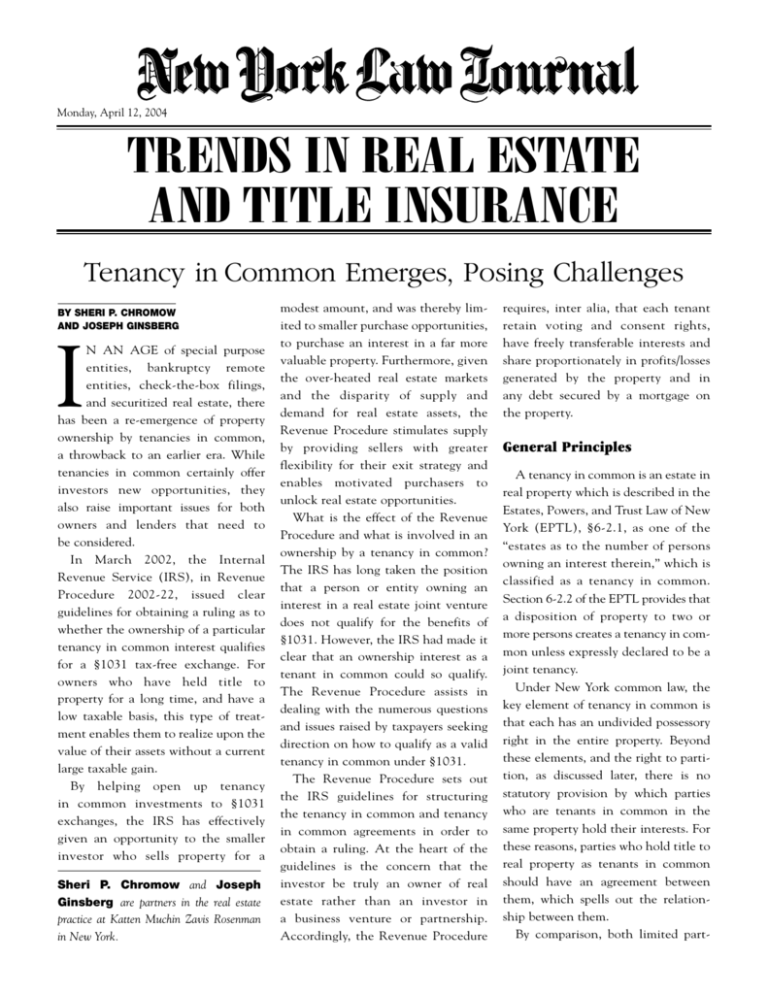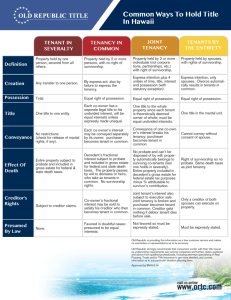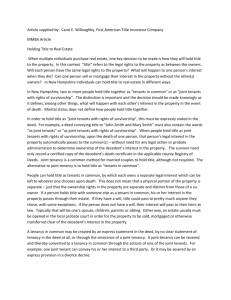
Monday, April 12, 2004
TRENDS IN REAL ESTATE
AND TITLE INSURANCE
Tenancy in Common Emerges, Posing Challenges
BY SHERI P. CHROMOW
AND JOSEPH GINSBERG
I
N AN AGE of special purpose
entities, bankruptcy remote
entities, check-the-box filings,
and securitized real estate, there
has been a re-emergence of property
ownership by tenancies in common,
a throwback to an earlier era. While
tenancies in common certainly offer
investors new opportunities, they
also raise important issues for both
owners and lenders that need to
be considered.
In March 2002, the Internal
Revenue Service (IRS), in Revenue
Procedure 2002-22, issued clear
guidelines for obtaining a ruling as to
whether the ownership of a particular
tenancy in common interest qualifies
for a §1031 tax-free exchange. For
owners who have held title to
property for a long time, and have a
low taxable basis, this type of treatment enables them to realize upon the
value of their assets without a current
large taxable gain.
By helping open up tenancy
in common investments to §1031
exchanges, the IRS has effectively
given an opportunity to the smaller
investor who sells property for a
Sheri P. Chromow and Joseph
Ginsberg are partners in the real estate
practice at Katten Muchin Zavis Rosenman
in New York.
modest amount, and was thereby limited to smaller purchase opportunities,
to purchase an interest in a far more
valuable property. Furthermore, given
the over-heated real estate markets
and the disparity of supply and
demand for real estate assets, the
Revenue Procedure stimulates supply
by providing sellers with greater
flexibility for their exit strategy and
enables motivated purchasers to
unlock real estate opportunities.
What is the effect of the Revenue
Procedure and what is involved in an
ownership by a tenancy in common?
The IRS has long taken the position
that a person or entity owning an
interest in a real estate joint venture
does not qualify for the benefits of
§1031. However, the IRS had made it
clear that an ownership interest as a
tenant in common could so qualify.
The Revenue Procedure assists in
dealing with the numerous questions
and issues raised by taxpayers seeking
direction on how to qualify as a valid
tenancy in common under §1031.
The Revenue Procedure sets out
the IRS guidelines for structuring
the tenancy in common and tenancy
in common agreements in order to
obtain a ruling. At the heart of the
guidelines is the concern that the
investor be truly an owner of real
estate rather than an investor in
a business venture or partnership.
Accordingly, the Revenue Procedure
requires, inter alia, that each tenant
retain voting and consent rights,
have freely transferable interests and
share proportionately in profits/losses
generated by the property and in
any debt secured by a mortgage on
the property.
General Principles
A tenancy in common is an estate in
real property which is described in the
Estates, Powers, and Trust Law of New
York (EPTL), §6-2.1, as one of the
“estates as to the number of persons
owning an interest therein,” which is
classified as a tenancy in common.
Section 6-2.2 of the EPTL provides that
a disposition of property to two or
more persons creates a tenancy in common unless expressly declared to be a
joint tenancy.
Under New York common law, the
key element of tenancy in common is
that each has an undivided possessory
right in the entire property. Beyond
these elements, and the right to partition, as discussed later, there is no
statutory provision by which parties
who are tenants in common in the
same property hold their interests. For
these reasons, parties who hold title to
real property as tenants in common
should have an agreement between
them, which spells out the relationship between them.
By comparison, both limited part-
NEW YORK LAW JOURNAL
nership and limited liability company
entities are recognized creatures of
statute. Partners or members own an
interest in an entity, not in the
real property. The statutes provide
for management of the entity by a
general partner or managing partner.
Such managing partner manages the
day-to-day affairs of the entity
subject to votes of the limited
partners or members, as provided in
the governing agreement.
In both a limited liability company
and limited partnership, a managing
partner or member has the ability to
bind the entity, subject to obtaining
the consents of the other partners
and members in accordance with the
governing agreement. Because the
partners or members in these entities
hold interests in the entities and not
in the real property, their interests
cannot be exchanged under the
Revenue Procedure.
Partition
One of the basic rights of a tenant
in common, not found in most other
ownership structures, is the right to
seek partition. In New York this right
is codified under §901 of the Real
Property and Proceedings Law. Such
action enables any of the tenants
in common to compel a partition of
the property or a sale of the property
where partition cannot be made
without prejudice to the owners.
Under the Revenue Procedure, each
tenant in common must retain the
right to partition without the agreement or approval of any third party.
However, the Revenue Procedure
provides that restrictions may be
put on partition rights where it is
required by a lender and it is “consistent with customary commercial
lending practices.” Tenants in common may and should waive the rights
MONDAY, APRIL 12, 2004
to partition against each other. It
is critical this waiver complies with
both the applicable common law and
the Revenue Procedure.
It is well-established under New
York case law that a court will recognize and uphold an agreement by
a party not to seek partition. Chew
v. Sheldon, 214 N.Y. 344 (1913),
Leonardo v. Leonardo, 297 A.D.2d
416 (3d Dept., 2002), McNally v.
McNally, 129 A.D.2d 686 (2d Dept.
1987). However, courts have stated
that the restriction period must be
for a specified period and of a
reasonable duration. Luvera v.
Luvera, 119 A.D.2d 810 (2d Dept.
------------------------------------------------
At the heart of the
guidelines is the concern
that the investor be
truly an owner of real
estate rather than
an investor in a business
venture or partnership.
------------------------------------------------
1986), Levy v. Herson, 127 Misc.2d
634 (Sup. Ct. 1985). However, they
do not spell out what constitutes a
reasonable duration.
Agreements
Tenancy in common agreements
will look much like agreements for a
limited partnership or limited liability
company. One tenant in common
will be the day-to-day manager of the
property, dealing with any tenants
of the property as well as any lender.
However, the Revenue Procedure’s
guidelines as to the voting and control
rights which each tenant must retain,
including rights pertaining to leasing
and the hiring of a manager, must be
complied with. The agreement should
also set out the purpose of the venture
and the obligations of the parties.
Unlike a limited partnership or
limited liability company, each party
will file tax returns for its own tenancy
in common interest.
In addition, as discussed below, the
agreement should require that (i) any
party desiring partition must first offer
to sell its interests to the other tenants
and that (ii) the other tenants are
required to purchase such interests.
Tax Structuring Issues
When purchasers of property structure a transaction to accommodate a
tenancy in common structure, they
are adding a variable to what would
otherwise be an entity of purchaser’s
choosing. In addition to carefully
structuring the method of getting
some portion of current cash to the
seller, the purchasers must integrate
the tenant in common in a way that
limits the tenant in common’s ability
to make decisions and also ensures
that a tenant in common’s bankruptcy
filing will not disrupt the purchaser’s
plans for the property.
The seller should consider having
more than one tenancy in common
interest, so that it can enter into more
than one 1031 exchange. The
purchaser will have to plan for this in
its structure and also consider, for tax
purposes, how long the seller must
wait before an exchange can be made.
Such a structure will require sophisticated counsel.
Tips for Lenders
Because lenders are accustomed to
(and from a servicing perspective,
often only equipped to) dealing with a
single borrower, it is important that a
tenancy in common loan involving
multiple borrowers be streamlined.
NEW YORK LAW JOURNAL
Each tenant in common must be a
party to any loan documents under the
Revenue Procedure as well as for the
benefit of the lender.
The loan documents and the
tenancy in common agreement should
be written to allow the lender to deal
only with the appointed manager.
Notice requirements should be
satisfied by notifying only such party.
In addition to these administrative
issues, the lender should make sure
that it is named as a third party
beneficiary under the tenancy and
management agreements. Furthermore, under the loan documents,
each tenant in common should
be treated separately in terms of
representations, covenants and other
guaranties, as appropriate.
In order to deal with the bankruptcy risk inherent in a transaction
with multiple borrowers, Standard
and Poor’s guidelines provide (i) each
borrower/tenant should be a bankruptcy remote special purpose entity
(SPE) and (ii) non-consolidation
opinions should be provided for each
tenant in common. However, some
investors may hold interests in entities which may not have sufficient
flexibility to convert into an SPE.
Remember, entities that become tenants in common will often have been
in existence long before SPE requirements came into being. How then
does a lender protect itself? One thing
a lender can do is obtain a recourse
carveback guaranty from a creditworthy guarantor and make certain that
such guaranty covers any bankruptcy
filing, in addition to covering other
steps which may be taken by a tenant
in common to prevent enforcement
of the loan documents.
As noted earlier, a lender must build
protections against partition into its
loan documents. The loan documents
MONDAY, APRIL 12, 2004
should strictly prohibit bringing a
partition action while the loan is
outstanding; otherwise the prospect of
a forced sale would loom perpetually
through the term of the loan. Such
restriction should also be covered by a
recourse carveback guaranty by each
tenant in common.
Second, the lender must be sure that
as part of both the tenancy agreement
and the loan documents, any party
desiring partition is required to offer
to sell its interests to the other tenants
and those tenants are required to
purchase such interests. The Revenue
Procedure expressly permits a first
offer requirement. Finally, because
of the uncertainty surrounding such
restrictions under the common law
and the Revenue Procedure, a legal
opinion should be required from
borrower’s counsel concerning its
enforceability. The opinion will most
likely be a reasoned one. The
foregoing complies with Standard and
Poor’s guidelines for tenancy in
common transactions.
With respect to the permissibility
of the waiver of partition under the
Revenue Procedure, there is little
direction given by the IRS or case
law. However, it would seem that
a lender would be on solid ground
taking the position that such waiver
is consistent with customary lending
practices. Regardless, a legal opinion,
even a reasoned opinion consistent
with the above analysis, should
be required.
Regulatory Issues
In the post 9/11 era, government
legislation has had a dramatic impact
on lenders’ policies and requires
that lenders do adequate due
diligence on their borrowers. Each
tenant in common should be
separately analyzed for compliance
with a lender’s policies.
Any loan agreement should contain, at the least, some language
stating that each tenant in common,
any guarantor, and their respective
affiliates are not and shall not become
a person with whom the lender is
restricted from doing business under
regulations: the Office of Foreign
Asset Control (OFAC) of the Department of the Treasury (including,
but not limited to, those named on
OFAC’s Specially Designated and
Blocked Persons list); under any
statute, executive order (including,
but not limited to, the Sept. 24, 2001,
Executive Order Blocking Property
and Prohibiting Transactions With
Persons Who Commit, Threaten to
Commit, or Support Terrorism); or
under other governmental action
relating to terrorism financing, terrorism support and/or otherwise relating
to terrorism. Some lenders add
ongoing covenants and indemnities
relating to OFAC to ensure ongoing
compliance.
Conclusion
While the Revenue Procedure offers
investors broader opportunities to
defer realization of taxable gain on the
sale of real property as well as to
exchange those interests into other
real property interests, it also presents
new challenges to both owners and
lenders. By considering all of the issues
and following the guidelines, the risks
posed by tenancies in common can be
adequately mitigated.
This article is reprinted with permission from the
April 12, 2004 edition of the NEW YORK LAW
JOURNAL. © 2004 ALM Properties, Inc. All
rights reserved. Further duplication without permission is prohibited. For information contact,
American Lawyer Media, Reprint Department at
800-888-8300 x6111. #070-04-04-0028
Sheri P. Chromow
Joseph Ginsberg
Partner
New York, New York
p_212.940.8529 f_212.894.5527
sheri.chromow@kmzr.com
Partner
New York, New York
p_212.940.8531 f_212.894.5931
joseph.ginsberg@kmzr.com
Ms. Chromow has extensive experience in a wide range of
real estate and corporate transactions, both in the United
States and overseas. She has been active in highly structured
transactions, leveraged lease transactions, capital market
finance, securitizations and syndicated loans, portfolio sales
and acquisitions, construction loans, REIT and corporate
loans, hotels and restructurings. Ms. Chromow has also
advised clients in all aspects of joint ventures and equity
acquisitions and the establishment of REITs, private
investment funds and exchange funds. She has worked on
acquisitions and dispositions of property throughout the
United States. She is currently representing American
investors in Europe and European investors in the United
States.
Ms. Chromow also has extensive experience in restructuring
credit facilities and enforcement of creditors rights, including
bankruptcy.
Joseph Ginsberg focuses his practice on real estate conveyances, finance, leasing and development. He has broad
experience throughout the United States in the acquisition
and sale of office buildings,shopping centers and hotels, and
in lease transactions involving office, industrial and retail
space, representing both landlords and tenants. He represents a variety of lenders and borrowers in a broad range of
real estate finance matters involving office buildings,
condominum conversions, hotels and shopping centers. Mr.
Ginsberg has advised clients in complex operating and
partnership agreements. He has represented owners and
developers in numerous residential and office building
development projects throughout the Northeast.
Mr. Ginsberg also has broad experience in commercial and
real estate litigation matters. He has successfully represented
clients in both state and federal courts.
She has lectured on workouts, foreign investment in U.S. real
estate, banking and leasing.
Ms. Chromow attended Barnard College and received her
B.A. in 1968 and earned her J.D. from New York University
School of Law in 1971. She is admitted to practice in New
York.
www.kmzr.com
525 West Monroe Street
Suite 1600
Chicago, IL 60661-3693
Tel 312.902.5200
Fax 312.902.1061
575 Madison Avenue
New York, NY 10022-2585
Tel 212.940.8800
Fax 212.940.8776
2029 Century Park East
Suite 2600
Los Angeles, CA 90067-3012
Tel 310.788.4400
Fax 310.788.4471
401 South Tryon Street
Suite 2600
Charlotte, NC 28202-1935
Tel 704.444.2000
Fax 704.444.2050
260 Sheridan Avenue
Suite 450
Palo Alto, CA 94306-2047
Tel 650.330.3652
Fax 650.321.4746
One Gateway Center
Suite 2600
Newark, NJ 07102-5397
Tel 973.645.0572
Fax 973.645.0573
1
1025 Thomas Jefferson St., N.W.
East Lobby, Suite 700
Washington, DC 20007-5201
Tel 202.625.3500
Fax 202.298.7570
04/28/2004





